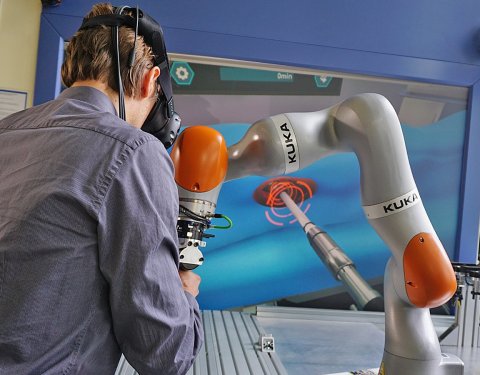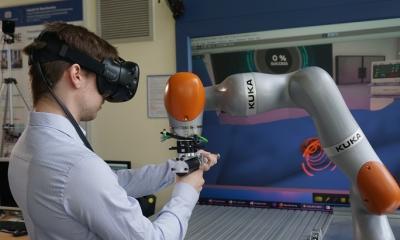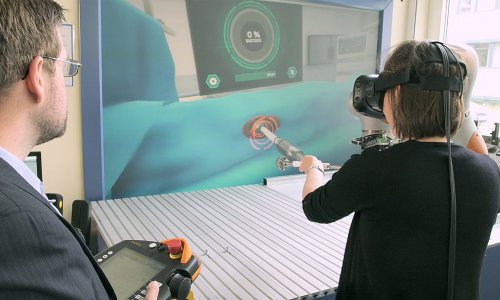Video • VR simulator "HIPS"
Hip joint implantation in virtual reality
Researchers from Chemnitz and Bremen are developing a virtual reality simulator for a particularly critical step in hip joint implantation.
Each year, more than 200,000 people receive a prosthetic hip in Germany. The success of these operations has a major impact on the quality of life of those affected. However, the procedure is often difficult, particularly the step that involves the so-called milling out of the acetabulum, one of the most delicate and difficult steps to practice. This is where the project “HüftImplantatPfannenfräsSimulator” (HIPS) steps in, funded by the Federal Ministry for Economic Affairs and Energy (BMWi). The project, successfully completed in April 2019, was led by the Professorship Machine Tool Design and Forming Technology at Chemnitz University of Technology. The Center for Computing Technologies (TZI) at the University of Bremen provided research expertise in the field of virtual reality. Also involved in the project were FAKT Software GmbH in Leipzig and CAT Production GmbH in Munich.
As a team, we are motivated to make additional procedures trainable using VR
Mario Lorenz
Taking part on the medical side of the project are the Department of Orthopedics, Trauma Surgery and Plastic Surgery at the University Hospital Leipzig, the Center for Research on the Musculoskeletal System (ZESBO) at the University Hospital Leipzig, the Department of Anatomy at the University of Otago (New Zealand), and the Medical Technology Department of the Fraunhofer Institute for Machine Tools and Forming Technology (IWU).
The scientists are currently planning the further development of the system, in order to be able to map additional surgical procedures. Aspiring surgeons should then be able to train on procedures such as the separation of the femoral head, the scraping of the femur, and the implanting of the artificial joint, all in virtual reality. “With the successful completion of HIPS, we have developed the world’s first surgical VR system for non-minimally invasive operating procedures with haptic feedback. However, this success is only a first step, and as a team, we are motivated to make additional procedures trainable using VR,” says Mario Lorenz from Chemnitz University of Technology, initiator of the cooperative project.

Hip implants must fit as accurately as possible in the acetabulum, in order to avoid complications and maximize the life of the prosthetic. The corresponding operation is quite complex, and requires a lot of power, along with great precision. Adding to this challenge, the site of the operation is barely visible to the surgeon. So far, it has been hardly possible to practice this procedure under realistic conditions.
Users of the HIPS system use VR glasses to see the hip of the virtual patient, while at the same time operating a milling machine that is connected to a robotic arm. The robot provides realistic haptic feedback, for example, by providing virtual resistance that would normally take place on the bone during the milling process. “Real data provides the basis for this realistic simulation,” explains Prof. Dr Gabriel Zachmann from the University of Bremen. “In order to gather the data, we precisely measured the milling process and developed corresponding algorithms.” FAKT Software GmbH integrated the resulting software modules into an interactive application that is based on an anatomical 3D model provided by CAT Production GmbH.
With the successful implementation of the collaboration, the project consortium recently impressed the jury of the German Institute for Virtual Reality (DIVR). The institute awarded HIPS the 2019 DIVR Award in the category of “Best Tech”. The jury praised the outstanding quality, high degree of technical innovation and the societal influence of the virtual reality simulation. “Receiving this award is a great honor for us and recognizes our work. It confirms us in our decision to intensify research in this area.” says Dr.-Ing. Philipp Klimant, Chief Executive Engineer of the Professorship Machine Tool Design and Forming Technology.
Source: TU Chemnitz
13.08.2019










